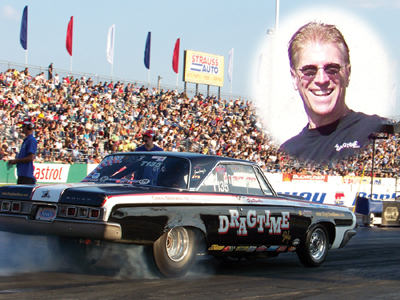(Article
begins on the Bracket Racing 101 page HERE)
 In
my columns Take Action For Reaction and Take Action For
Reaction Part II, I discussed the two major components that
comprise reaction time - the driver’s reaction to
the tree and the vehicle’s reaction to the driver.
The latter is somewhat easily adjusted: if the vehicle is
leaving too quickly or too slowly the driver can leave at
a different RPM, change the pressure of the slicks, or change
the travel of the front suspension. But in the case of the
driver’s reaction time, what can be done if he or
she is just inherently slow? Remember, both components of
reaction time must equal .500 in order to equal a .000 light
(assuming a 5-tenths tree). In
my columns Take Action For Reaction and Take Action For
Reaction Part II, I discussed the two major components that
comprise reaction time - the driver’s reaction to
the tree and the vehicle’s reaction to the driver.
The latter is somewhat easily adjusted: if the vehicle is
leaving too quickly or too slowly the driver can leave at
a different RPM, change the pressure of the slicks, or change
the travel of the front suspension. But in the case of the
driver’s reaction time, what can be done if he or
she is just inherently slow? Remember, both components of
reaction time must equal .500 in order to equal a .000 light
(assuming a 5-tenths tree).
In the
first Take Action column, I detailed how to use a practice
tree to determine your own reaction time. In the second
Take Action column I discussed vehicle reaction. If either
of these is sufficiently slow enough AND you’re racing
in a bracket class where you are likely to come up against
much faster and therefore quicker-reacting vehicles, then
deep staging should be considered.
I’m
not advocating deep over shallow, but there are situations
in ET bracket racing where staging deep should be considered.
For example, if you and your car are no better than .080
- .090 when staged shallow on a pro tree, then the only
way you’ll able to cut a good light with that vehicle
on a full tree when staged shallow will be to follow the
tree down and anticipate when to leave. This is not typically
a consistent way to race.
In addition
to cutting a light with a slow-reacting vehicle/driver combination,
there are some other benefits to staging deep. First, you’ll
be able to stage at a much lower RPM (typically somewhere
between 1,800 – 2,400), so you’ll be putting
a lot less stress on your parts and heat into the motor,
converter and transmission. As a result parts breakage is
reduced. Tire spin becomes much less of an issue, again
because of the low launch RPM, so consistency can improve.
What
should you do if your combination warrants experimenting
with deep-staging? First, check with your track and/or division
to find out their policy on deep-staging. Can it be written
on the car? In NHRA Division 1, for example, it cannot.
Also familiarize yourself with the track’s tree settings.
Do they use Autostart? What are the timeouts? I’ll
be discussing Autostart more in depth in a future column.
Lastly, be considerate. If you’re going deep, get
in first; don’t hang your opponent out by taking a
long time to knock out the top light. Deep-staging is a
privilege, not a right.
The
whole purpose of ET bracket racing is to give vehicles of
different performance levels an equal chance at success.
A vehicle's performance level can determine that vehicle's
reaction, and in order for all the vehicles in a class that
has a large ET spread to have an equal chance at success,
some of the vehicles will need to be deep-staged. A 17.99
vehicle will have an inherent reaction-time disadvantage
to a 9.00 vehicle if both are staged shallow.
Allowing
bracket racers to stage shallow or deep as they deem necessary
ensures a more equal chance at success no matter the vehicle
and can help grow our sport by attracting new participants
who feel they might have a chance at winning regardless
of the ET performance of their particular vehicle or the
depth of their pockets. We should be doing everything we
can to attract and retain new participants and not lose
them to frustration over being shut-out at a chance to win
based solely on their type of vehicle or the limitations
of their budget. If deep-staging helps them cut a competitive
light and possibly go some rounds, perhaps they’ll
come back next week and keep the momentum going. |



